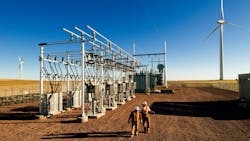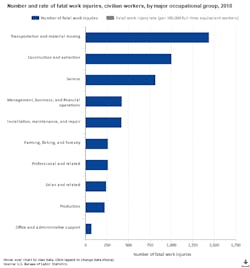Has Smart Grid Technology Impacted Utility Fatality Rates or Job Numbers?
The U.S. Bureau of Labor Statistics (BLS) recently reported there were 5250 fatal work injuries recorded in the United States in 2018, representing a 2% increase from the 5147 in 2017. Although there is no acceptable number of fatalities, the 44 deaths in 2018 in the North America Industry Classification System (NAICS) utilities sector were well below numerous other sectors. For all job classifications, homicides, roadway incidents, falls, and being struck by an object each resulted in more deaths than exposure to electricity. Is the lower fatality incident rate for utilities (2.6/100,000) compared with the construction industry (9.5/100,000) — which includes trade electricians — because of the implementation of digital and other smart grid technologies? Also, does the developing smart grid era portend fewer or more electric utility jobs?
BLS data historically identified being an electrician as one of the 10 most dangerous jobs. The data issued to date for 2018 provides a more nuanced story. Fatalities in the utilities sector, including all types of utility workers, were relatively low. Fatalities in the construction and extraction occupational sectors (see graphic) were high and within the 10 most dangerous classifications. The construction sector (NAISCS 23) includes specialty trade contractors (NAISICS 238), which covers electricians. While sector breakdowns do not include the number of fatalities by occupation, a straight percentage allocation of the total would indicate 160 electricians working as construction subcontractors lost their lives in 2018. To be clear, this is an estimate for comparison with the 44 utility employee deaths.
There are a host of job differences when comparing utility workers with electricians working as subcontractors, frequently on construction sites. One thought-provoking concept is that smart grid systems at utilities are affecting fatality rates by reducing or eliminating some of the most hazardous tasks. Consider advanced distribution management systems that can clear some grid faults and avoid having line workers make unnecessary trips during inclement weather. Also, look at the reduced exposure to energized cables resulting from the digitalization of substations and other grid components. The smart grid initiative also includes an increased emphasis on renewable energy and measures such as demand management. Such technologies may limit the transmission and distribution (T&D) of power, but they also place electrical systems in work settings where staff may not be adequately trained. However, there is no compelling evidence in literature to date indicating that smart grid technologies are impacting the incidence rate of workplace fatalities, even though some of the arguments both ways are logical.
Most electric utility employees don’t spend their time worrying about the singularity — a hypophysis concerning when technological advancement will overtake and potentially eliminate humankind. However, some may worry about technological advancements eliminating their jobs. It’s clear from our experience to date that some roles are becoming less essential while others will be created or a will have a higher priority. Consider the reduced need for meter readers with the adoption of advanced metering infrastructure (AMI) or the decline in customer service operators with automated response systems. Conversely, look at the increased and new roles in information services, analytics, and communications technology.
BLS data indicate utility worker jobs have declined by only 2.3% in the 10 years since the beginning of 2009. This is the same period during which we’ve seen huge investment in smart grid infrastructure by the electric industry. However, reviewing the data timeline below, one might argue the worker decline is more a vestige of the great recession which began in 2008 than a result of the adoption of smart grid technology.
A detailed assessment released nine years ago by the Illinois Institute of Technology (IIT) and West Monroe Partners predicted more than 100 job classifications in a range of businesses and industry subsectors would be affected by the expansion of smart grid technology. The study identified gaps between existing skills and competency levels relative to those needed for the transformation of the power industry. Further, it stated that the smart grid would bring new job duties, titles, and roles to the power industry, but stopped short of finding a major workforce expansion. In fact, the study reported that workforce growth could be hampered by learning curve pains and significant age-related worker attrition occurring in the industry. Time appears to have confirmed these predictions.
The fate of utility job numbers vis-a-vis the smart grid now squarely rests with utilities themselves. It’s fair to say we are past the learning curve pains and training shortages reported in the IIT study. Further, one industry assessment after another predicts high growth for the foreseeable future in smart grid technologies and their applications. The only question is will utilities seize on the new opportunities presented by this transformation and hire the employees needed to pursue them, or allow third-party businesses to fill the void?
About the Author
David Shadle
Grid Optimization Editor
Dave joined the T&D World team as the editor of the Grid Optimization Center of Excellence website in January 2016.
Dave is a power industry veteran with a history of leading environmental and development organizations, championing crucial projects, managing major acquisitions and implementing change. Dave is currently a principal at Power Advance, LLC, an independent consulting firm specializing in power project development, research and analysis, due diligence and valuation support. Dave is also a contributing consultant for Transmission & Distribution World. Prior to Power Advance, Dave held business and power project development positions with The Louis Berger Group, Iberdrola Renewables, FPL Energy and General Public Utilities. He is a graduate of Pennsylvania State University, the New Jersey Institute of Technology and Purdue University.


